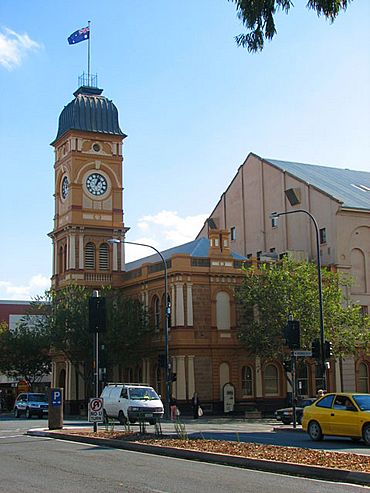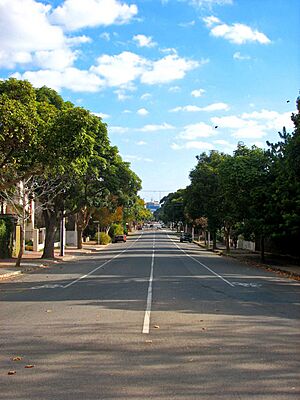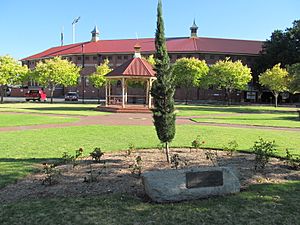Norwood, South Australia facts for kids
Quick facts for kids NorwoodAdelaide, South Australia |
|||||||||||||||
|---|---|---|---|---|---|---|---|---|---|---|---|---|---|---|---|

The Norwood Town Hall on The Parade
|
|||||||||||||||
| Population | 5,953 (2016 census) | ||||||||||||||
| Established | 1847 | ||||||||||||||
| Postcode(s) | 5067 | ||||||||||||||
| Location | 4 km (2 mi) from Adelaide | ||||||||||||||
| LGA(s) | City of Norwood Payneham & St Peters | ||||||||||||||
| State electorate(s) | Dunstan | ||||||||||||||
| Federal Division(s) | Sturt | ||||||||||||||
|
|||||||||||||||
Norwood is a suburb in Adelaide, the capital city of South Australia. It's located about 4 kilometres (2.5 miles) east of the Adelaide city centre. Norwood is part of the City of Norwood Payneham & St Peters. This local government area was actually the very first one established in South Australia!
Contents
Norwood's Past: A Quick Look at History
Norwood got its name from a place called Norwood in London, England. The suburb was first planned and set up way back in 1847.
Exploring Norwood's Geography
Norwood is divided into four main parts. The main road, The Parade, splits it into north and south. Osmond Terrace divides it into east and west.
The suburb is surrounded by other areas. Kensington Road is to the south, and Magill Road is to the north. Portrush Road is on the east side, and Fullarton Road is on the west.
Norwood is known for its many trees, especially plane trees, which line the streets. You'll find lots of older houses here. However, in recent years, more modern, taller buildings have been built. This makes Norwood a very popular place to live today.
Important Landmarks in Norwood
Osmond Terrace has a wide grassy area in the middle. Here, you'll find a special war memorial. It honours the ANZAC soldiers who fought in World War I and World War II.
Two of the most famous buildings in Norwood are the Norwood Town Hall and the Clayton-Wesley Uniting Church. The church is actually in Beulah Park, but it's so tall you can see it from far away on The Parade. It was built over 150 years ago!
Who Lives in Norwood? A Look at Demography
After World War II, many people from Europe moved to Norwood. A lot of these new residents were Italians.
In 2016, there were 5,953 people living in Norwood. The main languages spoken at home, besides English, were Mandarin Chinese, Italian, and Greek.
Most people in Norwood were born in Australia (64.4%). The top family backgrounds were English and Australian.
Getting Around: Transport in Norwood
Norwood is well-served by Adelaide Metro buses. Several bus routes run through or next to the suburb.
Main bus routes include:
- H30, H33 on Magill Road
- H20, H21, H22, H23, H24, N22 on The Parade
- 140, 141, 142 on Kensington Road
- 300 (Suburban Connector) on Portrush Road
There are also special bus services for schools and for big events at Adelaide Oval.
Fun Things to Do: Norwood's Attractions
The Parade is the heart of Norwood's business area. It's famous for its many restaurants, cafes, and fashion shops. It's a lively and popular spot in Adelaide's eastern suburbs.
Sports and Clubs in Norwood
Norwood Oval: Home of the Redlegs
Norwood Oval, also known as Coopers Stadium, is on The Parade. It's the home ground for the Norwood Redlegs. They are a team in the South Australian National Football League (a type of Australian Rules Football). The oval also hosts some games for the AFL Women's league, including the Adelaide Crows.
Norwood Cycling Club: The Oldest in the Southern Hemisphere
The Norwood Cycling Club (NCC) is the biggest cycling club in South Australia. It has over 380 members! It was started in 1883, making it the oldest cycling club in the southern hemisphere.
The club was first called the Norwood Cycle and Motor Club. Its official opening was at Kensington Oval in 1884. Many famous cyclists have been members of the club, including Jack Bobridge and Tiffany Cromwell.
The club holds four big cycling events every year:
- The Noarlunga Road race (since 1919)
- The Burra 2-day Classic
- The Tour of the Riverland
- The AlphutteClassic Handicap
Important Buildings in Norwood
Norwood Town Hall
The Norwood Town Hall is a very important building. It was added to the SA Heritage Register in 1985, meaning it's protected because of its historical value.
Norwood Library
The Norwood Library is located at 110 The Parade. It's in an old building that used to be the Kensington and Norwood Institute. This building was also added to the South Australian Heritage Register in 1981.
The institute was built in 1876 and was one of many "mechanics' institutes" from the 1800s. These places helped people learn and borrow books. The library's collection grew over time. In 1977, the local council took over the building and kept the library running. Today, it's a refurbished library with a classic style.
Former Norwood Baptist Church
The old Norwood Baptist Church is on Church Avenue and The Parade. It was built in 1869 and is also on the SA Heritage Register. Its design was inspired by a famous church in London.
This building has one of the most important church organs in South Australia, installed in 1882. It's no longer a church. For a while, it was a bookshop, and now it's a restaurant.
Images for kids




